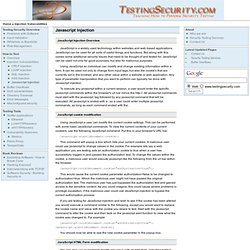

Beginner’s Guide to OAuth – Part I: Overview. The OAuth 1.0 Guide. OAuth Core 1.0 (also known as RFC 5849), the community-based specification published on December 4th, 2007, revised June 24th, 2009, and finalized in April 2010 is one of the fastest growing Open Web specifications.

It provides a much needed solution for security web APIs without requiring users to share their usernames and passwords. This guide attempts to explain OAuth by taking a look at its history, architecture, and technical details. It is written primarily for developers looking to implement services offering secure APIs or developers implementing clients using OAuth-protected services. The OAuth specification has gone through a few complete rewrites. New Approaches To Designing Log-In Forms - Smashing Magazine.
Advertisement For many of us, logging into websites is a part of our daily routine.

In fact, we probably do it so often that we’ve stopped having to think about how it’s done… that is, until something goes wrong: we forget our password, our user name, the email address we signed up with, how we signed up, or even if we ever signed up at all. These experiences are not just frustrating for us, but are bad for businesses as well. How bad? User Interface Engineering’s analysis of a major online retailer found that 45% of all customers had multiple registrations in the system, 160,000 people requested their password every day, and 75% of these people never completed the purchase they started once they requested their password. Using mod_ssl on Mac OS X. Survival Guide - SSL/TLS and SSL (X.509) Certificates (Self-Signed) This is a survival guide to the eye-glazing topic of TLS/SSL and X.509 (SSL) certificates - including self-signed certificates.

These are elements in what is loosely called a Public Key Infrastructure (PKI). What are colloquially known as SSL certificates should be referred to as X.509 certificates. The term SSL certificate became common due to the adoption of the X.509 (one of the ITU X.500 Directory standards) certificate format by Netscape when it designed the original versions of the SSL protocol, eons ago, when the world was still young and the Internet was a friendly place. The term 'SSL certificate' has persisted simply because given the choice of saying SSL certificate or 'X.509 certificate' which would you choose?
The current guide includes SSL, TLS, some detail about X.509 and its usage as well as some explanation about certificate types, including EV certificates, and the trust process. If, however, you just want to read the blasted RFC, feel free to click the links below.
XSS. VI Support - Secure.Virtuality information. The State of Web Security Issues. By Ryan Barnett, director of application security research at Breach Security February 17, 2010 08:33 PM ET Network World - While security vulnerability research can expose technical weaknesses that may be exploited, incident research provides in-depth information about the most common targets, motives and attack vectors of modern hackers.

And where better to turn for a sense of where we stand today than the Web Hacking Incidents Database (WHID). Analysis of WHID reveals that in 2009 social networks were at the greatest risk, malware and defacement remained the most common outcome of Web attacks, and SQL injection was the most common attack vector. Here’s a deeper dive on the findings and what you can do about them.
Perhaps not surprisingly, analysis of Web hacking incidents reveals that social network sites such as Twitter and Facebook are becoming premier targets for hackers. Can't Install Security Compliance Manager. Free PHP/MySQL Login Script. JavaScript Injection Attack. As little as a year ago, the bad guys were dependent on enticing people to follow links that pointed to malicious websites (via e-mail, search links, or IM worms).

Today, they are using JavaScript injection attacks to simply "steal" a website's visitors, and it has become something of a Swiss Army Knife for underground hackers to spread their malware worldwide. We've seen numerous high traffic, legitimate websites attacked using this technique. JavaScript Security Slides from No Fluff Just Stuff - Blogs at Near Infinity. Software security testing: Finding your inner evildoer. In my experience as both a software security engineer and trainer, it has become clear to me that some students catch on to the concepts faster than others.

Often, those who tend to excel don't immediately show signs of brilliance. Frequently, a seasoned tester who can hunt down functional bugs in the weirdest of places can't make the transition to security testing very easily. Javascript Injection. JavaScript Injection Overview JavaScript is a widely used technology within websites and web based applications.

JavaScript can be used for all sorts of useful things and functions. But along with this comes some additional security issues that need to be thought of and tested for. JavaScript can be used not only for good purposes, but also for malicious purposes. Using JavaScript an individual can modify and change existing information within a form. To execute any javascript within a current session, a user would enter the specific javascript commands within the browser's url bar minus the All javascript commands must start with the javascript: tag followed by any javascript command that will be executed. JavaScript cookie modification Using JavaScript a user can modify the current cookie settings. Javascript:alert(document.cookie); This command will popup a box which lists your current cookies. Javascript:void(document.cookie="authorization=true"); JavaScript HTML Form modification.